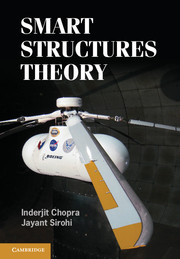Book contents
- Frontmatter
- Contents
- Preface
- 1 Historical Developments and Potential Applications: Smart Materials and Structures
- 2 Piezoelectric Actuators and Sensors
- 3 Shape Memory Alloys (SMAs)
- 4 Beam Modeling with Induced-Strain Actuation
- 5 Plate Modeling with Induced-Strain Actuation
- 6 Magnetostrictives and Electrostrictives
- 7 Electrorheological and Magnetorheological Fluids
- 8 Applications of Active Materials in Integrated Systems
- Index
Preface
Published online by Cambridge University Press: 18 December 2013
- Frontmatter
- Contents
- Preface
- 1 Historical Developments and Potential Applications: Smart Materials and Structures
- 2 Piezoelectric Actuators and Sensors
- 3 Shape Memory Alloys (SMAs)
- 4 Beam Modeling with Induced-Strain Actuation
- 5 Plate Modeling with Induced-Strain Actuation
- 6 Magnetostrictives and Electrostrictives
- 7 Electrorheological and Magnetorheological Fluids
- 8 Applications of Active Materials in Integrated Systems
- Index
Summary
In 1990, a pilot project was started at the Alfred Gessow Rotorcraft Center (University of Maryland) to build a smart rotor with embedded piezoelectric strips. Soon, it attracted the attention of Dr. Gary Anderson of the Army Research Office (ARO). He encouraged us to put together outlines for a major initiative in the smart structures area, which subsequently resulted in the award of a multi-year (1992–1997) University Research Initiative (URI). This provided us an opportunity to develop an effective team of interdisciplinary faculty from Aerospace, Mechanical, Electrical, and Material Engineering. As a result, there was an enormous growth of smart structures research activities on our campus. Following the success of this URI, we were awarded another multi-year (1996–2001) Multi University Research Initiative (MURI) in smart structures by ARO. For this major program, we collaborated with Penn State and Cornell University. This further nurtured the ongoing smart structures activities at Maryland. We deeply acknowledge the support and friendship of many faculty colleagues at Maryland: Appa Anjannappa, Bala Balachandran, James Baeder, Amr Baz, Roberto Celi, Ramesh Chandra, Abhijit Dasgupta, Allison Flatau, James Hubbard, P. S. Krishnaprasad, Gordon Leishman, V. T. Nagaraj, Darryll Pines, Don Robbins, Jim Sirkis, Fred Tasker, Norman Wereley, and Manfred Wuttig.
While the research frontier in smart structures was expanding at the Alfred Gessow Rotorcraft Center, we also initiated classroom teaching at the graduate level in the smart structures area.
Information
- Type
- Chapter
- Information
- Smart Structures Theory , pp. xvii - xviiiPublisher: Cambridge University PressPrint publication year: 2013
